Do you frantically flip through a textbook the night before an exam, trying to cram as much information as possible into your brain? Or maybe you’re an office worker poring over reports and emails, trying to keep up with the constant flow of information.
We’ve all been there, feeling overwhelmed and frustrated by our reading abilities.
Good News is, there is hope for all your reading goals. Just as we can strengthen any other muscle in our bodies, we can train our brains to read faster. You don’t need to be gifted with an extraordinary brain.
But, here’s the Bummer: Speed reading skills aren’t worth a dime if you don’t retain any information.
In this blog, we will share our top tips and techniques for improving your reading speed and comprehension. Whether you are a student looking to improve your study habits, a professional looking to increase your productivity, or simply someone who wants to read more efficiently, these techniques will be useful for you.
So let’s get started on our journey to becoming speed reading masters!
Want to join the ranks of the world's fastest readers?
Enroll in our program – Speed Reading Genius with Howard Berg, the world’s fastest reader, and learn how to speed read with 100% comprehension now!
Table of Contents
ToggleHow to Measure Your Reading Speed?
The first step to improving your reading speed is knowing how many words you can read in a minute. You can find it yourself right now. Open a page of your favorite book (fiction or nonfiction). Just make sure you choose a book according to your goal.
If your goal is reading faster to study for exams, it is best to pick an academic book that matches your intellectual ability. Have a timer or stopwatch handy.

There are two sides to it, reading with and without comprehension.
For the first level, read at your maximum speed for a minute, and don’t worry about comprehension. Record the number of words you’ve covered in a minute. That is your reading speed in words per minute (WPM).
The average reading speed of adults is between 220-350 wpm. Now, repeat the experiment while trying to understand the text.
If the results are demotivating, set the timer aside and keep reading this blog. The later sections of this blog will not only help you increase your reading speed but also retain better with improved comprehension.
Factors Affecting Reading Speed
1. Memory
Do you remember the first word you ever read? Neither do I. We all were certainly trained how to read unless you are a unique snowflake who read The Great Gatsby Novel straight out of the womb.
The point is, in the beginning, we were trained to spell out the letters one by one, and then connect them to form a word. But as we grew, with a lot of reading over the years, the words we had to read letter by letter became a memory.
Now, Time for fun: What comes to your mind when you hear the word “cupcake”?
Is it a teacup-sized chocolate cake with a swirl of strawberry frosting and a cherry on the top, maybe covered with a liner?
Did you picture the cupcake as you read the previous line?
Can you reminisce about the smell that comes when the cupcake is straight out of the microwave?
Now, how did you know that?

It’s because you used all three senses, your ears, eyes, and nose to match the word with the memory you had. You wouldn’t have done any of those if you didn’t know what a cupcake is, how it smells, tastes or looks. That is why when the brain is trained to connect words with an existing memory, you can read faster.
2. Fixation
To understand this term, I want you to take a pen without a cap and point the nib toward the screen. Read the paragraph in the picture below. Move the pen as your eyes move along the text and notice the pattern your pen is moving.

Text Credits – The Alchemist
Do you see a pattern like this?
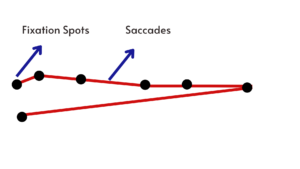
When a normal or slow reader reads, there are consequent saccades intermingled with short stops. The stop that prevents your eyes from continuous motion while reading is called fixation.
Normal or slow readers stop at least once after every line to comprehend. Fast readers can see and process 3 to 14 words in a single eye fixation.
They have less fixation time which means they can view a larger chunk of words at a time because eyes can move very quickly without interruption. The art of speed reading is when you train yourself to have less fixation throughout the reading session.
3. Vision span
Another term that has to do with the eye. If you are reading this blog on a mobile phone, can you see the time that is on the top right or left of your screen?
Or can you at least acknowledge that it’s there? At the same time can you see the words that are above and below this line? You don’t have to be able to understand the words, but you should be able to sense them around.
We have binocular vision. That means, with two eyes we can see a roughly 130-degree field of vision. Vision span is the range of letters or words that you can recognize without moving your eyes.
An interesting study by King Khalid University consisted of two groups (a control group and a test group), each consisting of 25 students who were tested for reading and comprehension scores before and after the training to expand their vision span.
It concluded that an increase in vision span had no negative effects on reading habits and comprehension but proved to improve the reading speed of both groups.
What Slows Down the Reading Speed?
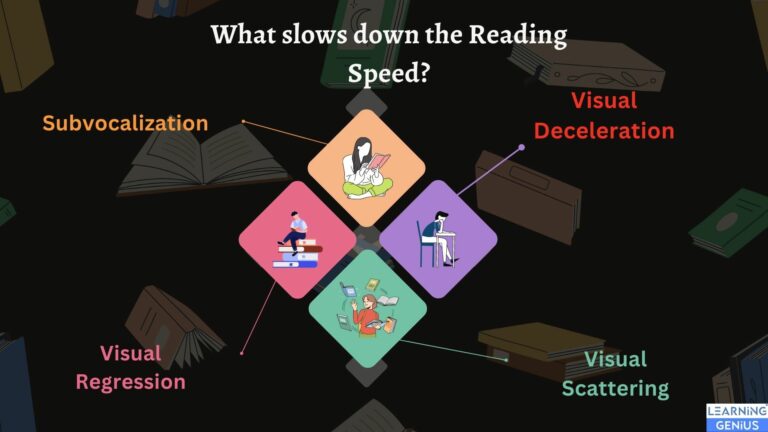
1. Subvocalization
As you read, do you say every word in your head? If it is a yes, it means you are reading only as fast as you can talk. Talking faster isn’t our goal and it is nearly impossible to match it with speed reading. That is the major problem. Subvocalization is a habit for most of us and it is difficult to eliminate it. Speed readers are trained to reduce subvocalization by distracting themselves with music or using their fingers as pointers as they read.
2. Visual Regression
How many times have you gone back to read the same paragraph again because you weren’t paying attention or couldn’t comprehend better the first time? This is visual regression. To avoid this, you need to be immersed while reading, minimizing distractions as much as possible. Taking notes, and listening to music can help you fix this issue.
3. Visual Deceleration
Authors can get very creative. Reading the narrative sometimes can be very relaxing and enjoyable, making us want to read it again and again. This is visual deceleration. Eliminating this phenomenon will kill the reading experience, but it is one of the major reasons why you are slow reading.
4. Visual Scattering
Imagine the first line of the book you are reading describes a healthy 25-year-old man shopping for groceries. While you are reading the very first line, your mind catches sight of the last line which says that the healthy man got into an accident. Your emotions get provoked, and you want to know what happened. So, you turn to the second page and start reading. After you learn what happened next, you want to know how the accident happened. You flip the page back and start reading from the beginning.
See what happened? You wasted time and this bad reading habit is caused by a phenomenon called visual scattering.
Combination of Psychological & Mechanical Techniques to Master Speed Reading
1. Bold Words Technique
We have seen how fixation alters reading speed. But you can mimic these fixation points by bolding the initial parts of the words. Your brain can quickly process the rest of the word without your eyes having to read every letter.
Here is an example-
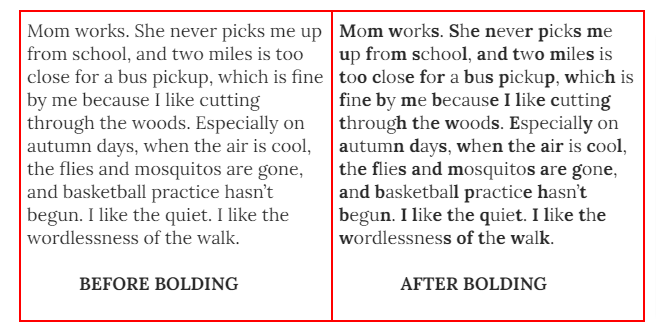
Text Credits – Apples and Trees
2. Hand Pacing
It’s nearly impossible for your eyes to move smoothly in one line. Eyes move in terms of saccades. The best way to improve reading speed is using a tracer. When your eyes are tracking something, be it your index finger or a pen, it scans the text, saving time while reading.
3. Increasing Competence
Four levels of competence determine your ability to perform a job. The highest level of competency is Unconscious competence which will strengthen your reading instincts, thus increasing the speed.
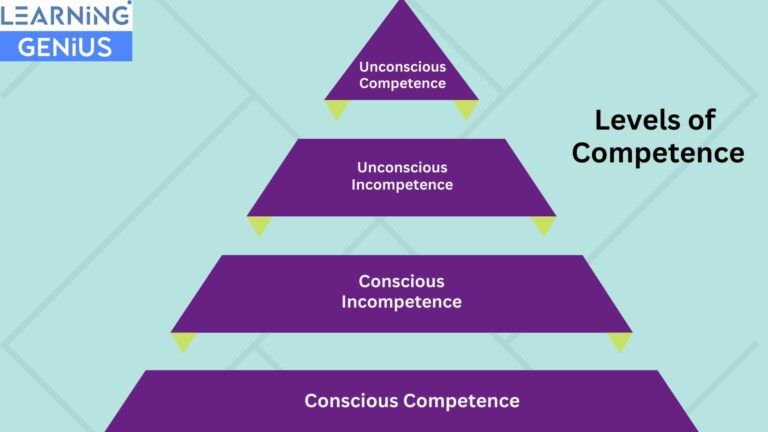
Learn How to Read Twice as Fast in 20 Minutes Without Opening Your Wallet
Unlock the secrets to reading twice as fast in just 20 minutes with this FREE course by Howard Berg, THE WORLD’S FASTEST READER
4. Become Immersive
As Csikszentmihalyi states in his book Flow: The Psychology of Optimal Experience,” flow is the state where people are so involved in an activity that nothing else seems to matter”.
If you notice professional chess players during a match, you will find how immersive they are the whole time. Nothing distracts them. They completely enjoy what they’re doing and they’ll do it at a great cost.
Once you learn the science of speed reading, with a lot of practice you will achieve this state of immersion.
5. Skim When Required
Skimming helps you to get a bird’s eye view of the reading material. It takes very little time and you can skip the boring parts and pay attention to important details. Skimming textbooks before your exams can be helpful to review concepts as you have already learned them.
6. Read From the Middle
Our eyes have a peripheral vision that can see words surrounding the word you are reading. But when you start reading from the first word of the line, you are wasting peripheral vision as it only has blank spaces. Tim Ferris’s “The four-hour workweek” recommends reading from a little between and tracking your eyes on both sides.
How to Increase Comprehension While Speed Reading
1. Get Familiar With The Words
Unless you are an attorney, you wouldn’t understand a word if you were told to speed-read a legal contract. It’s because you haven’t heard of those words before and your memory isn’t helping you visualize them either.
But if I give you an elementary alphabet illustration textbook, you would read them faster with full comprehension. The first step towards getting familiar with the words is going through the very common ones that make up 50- 70% of the text.
Words like ‘the’, ‘and’, ‘much’ and 312 other Dolch words appear very frequently in any text. When you go over the list multiple times, your brain puts it into its database and it becomes a habit to process these words quickly as you read. After enough practice, you will be able to skip these words entirely while you read and yet understand the text.
2. Vocabulary
As we already saw how memory affects reading, you should know that memory and vocabulary have a direct relationship when it comes to reading or comprehension. Reading too fast and not comprehending doesn’t do you any good. When you don’t know the meaning of the words while you read, it can take up a lot of time to process, remember and retain. If you are reading medical, legal, or any niche-specific books, you will find words with complex vocabulary very often.
The key is to first get familiarized with these words by knowing their meaning and picturing it so the next time your brain sees the word, it can connect it with a memory.
Sounds like too much work?
To take this burden off your shoulders, we have created a course on Speed Reading with better comprehension by Howard Berg, the world’s fastest reader.
In the course, we will provide you with a list of the 300 most difficult and most frequently occurring words in the English language, that could help you read and learn faster
3. Practice Schema
Has that ever happened to you? You read a few lines and then picture a story in your mind guessing how the rest of the paragraph goes. This phenomenon is known as rapid serial visual presentation.
For example, when you see words like “teacher” “student” and “blackboard”, your brain automatically assumes it is a “classroom” setup. This interpretation by linking patterns of words to form a visual memory is called schema.
When you read next time, try identifying individual words that are schematically correct and highlighting them. Then go over the reading material once again. This time, read only the highlighted words. You should be able to get the whole meaning of what the author is trying to say.

Text Credits – Liability in Lingotto
4. Understand the Levels of Learning
There are three levels in learning namely, Literal, Implied, and Inferential
Literal learning – Literal texts depict facts, data, or obvious information. It is the most fundamental type which allows you to recognize and connect words to their meaning.
Example – The Sun rises in the East.
Knowing letters, spellings, and words means we can recognize these words. For example, we know that s,u, and n put together in that order spells Sun. And by fact, we know that the Sun rises in the East.
Implied Learning- Implied information is those which you assume to be true to explain the words.
Example – The Human Brain has 26 billion neurons.
Through this level of learning, you or the author assume you know the following information
- What is a neuron?
- What is a brain?
- What is a Human?
Inferential learning – This advanced level of learning provokes your ability to go beyond the scope of the book. It involves looking at the text from multiple perspectives, which you will know in the next paragraph.
5. Read from Different Perspectives
The author usually writes based on his beliefs, culture, and social preferences. You as a reader should be able to acknowledge it while stressing your perspective.
The point of view of the author, you, and the third person is crucial to comprehend the text in and out while reading faster.
6. Break the Ritual
Instead of simply reading the text and accepting the facts as mentioned, try giving it a better logic. It will help you come up with questions that can simplify the concept even better.
For example, read the below proverb,
We are what we repeatedly do.
Excellent, then, is not an act but a habit
– Aristotle
Imagine the possible questions you can come up with after reading this. It can be,
Questions | Answers |
What is the goal of this proverb? | To become excellent |
What is the plan? | To repeat the things we do every day |
Should I repeat everything? | No. Only the things you want to be excellent at. |
You get it…
Memory Techniques: How to Retain Better
Can you recall the three core concepts from the book you read recently?
Learning to Read faster and more efficiently is a skill that comes with practice. But retaining that information and making it a long-term memory needs special attention.
Whether you want to study for exams, want to retain concepts from nonfiction, avoid forgetting something instantly after reading, or simply want to train your memory muscle, improving retention isn’t as tough as it sounds.
The following memory techniques will help you retain better
1. Index Cards
Index cards refer to the summary cards that help in reviewing the concepts you have learned. Research proves that using index cards to memorize facts, data or statistics are more effective for long-term memory. It also increases motivation and reduces friction. You can review the concepts while traveling or while having a snack.
Make sure you use short forms and symbols in the cards to train your schematic memory
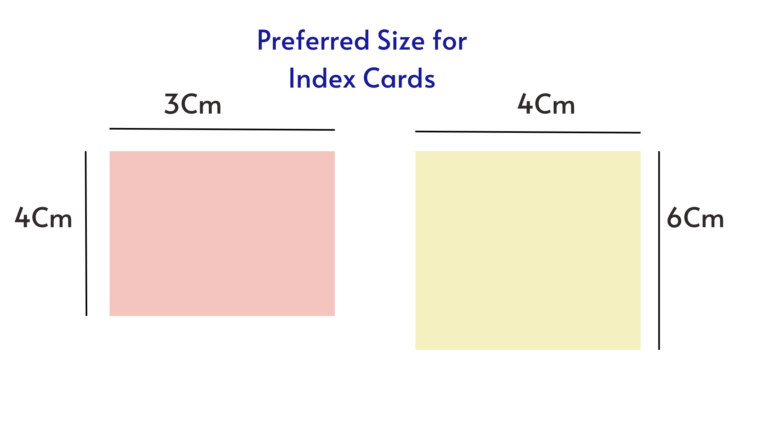
2. Pegging
The peg system is extremely useful to remember numbers. Here is the rhythmic peg list with specific words for each number
1 (one) = sun;
2 (two) = glue;
3(three) = knee;
4 (four) = door;
5 (five) = hive;
6 (six) = sticks;
7 (seven) = heaven;
8 (eight) = gate;
9 (nine) = vine;
0 (zero)= wart.
Let’s say you want to memorize the number 24598. It is glue, door, hive, vine, and gate. To remember these words, all you have to do is create a story of your own.
For example – I stuck up the glue on the door to prevent bee hives from entering. But instead, vines from the nearby gate entered.
3. Music
Playing background music while you read can help you focus and improve your memory. This phenomenon is called the Mozart Effect. You can listen to peaceful instrumental or harmonic music that doesn’t have lyrics in them.
4. Mnemonics
Mnemonics refers to patterns of letters, ideas, or images to aid your memory. Mnemonics like VIBGYOR help you remember the colors of the rainbow. You can create mnemonics of your own or use the standard ones from the internet.
Combine the concept of both mnemonics and the peg system to create a memory palace with your story in it. Each story will represent the concept you wish to remember. You can check out hundreds of patterns from mnemonic devices to memorize and remember things.
Wrapping Up…
Thank you for joining us on this journey to mastering speed reading. I hope that you have found the tips and techniques shared in this blog to be helpful and that you have already seen some improvement in your reading speed and comprehension.
Remember, the key to success in speed reading is practice and consistency. The more you practice these techniques, the more natural they will become and the faster you will be able to read.
Don’t be discouraged if you don’t see results overnight – improvement takes time and effort. Keep at it, and before you know it, you too will be on your way to becoming a speed reading master!
So, keep practicing and keep reading!
Reading Has Never Been So Fun
Read 2x Faster, No Cost Involved
Take control of your Reading Speed and Comprehension with the FREE Speed Reading Course By Howard Berg (Guinness Record Holder for reading 80 pages in a minute)
Frequently Asked Questions
- Does Reading more improve speed too?
Yes. All our speed reading strategies work as you practice more and more. Your brain learns to process words quickly with practice. We recommend you start practicing the techniques with a basic book and then slowly progress to your desired text.
- How to read faster without speed reading?
If you want to simply read faster without learning speed reading techniques, placing tracers like your fingers or the tip of the pen underneath the words and moving them along the motion of your eyes while reading can help you read faster. Have a timer handy always and track your time.
- How long does it take to learn Speed Reading?
It depends on the quality of techniques you are following and the amount of hard work you are ready to put in. It can take you somewhere between 2 weeks to a year. Our speed reading genius course by Howard Berg, the world’s fastest reader promises to triple your reading speed in less than 7 weeks. The course walks you through the advanced fast-reading techniques with everyday activities, exercises, and review sessions
- What is the best Speed Reading course?
It is always recommended to learn from the best speed reading trainer. Learning Genius offers a 7-week Speed Reading program taught by the only fastest reader, Howard Berg. He is respected internationally for his reading and comprehension scores, he is listed in the 1990 Guinness Book of World Records for reading more than 25,000 words a minute and writing more than 100 words a minute.
- Is Speed Reading effective?
Speed Reading rate when done with good comprehension and retention is proven to save a lot of time for students and professionals, especially from the medical, law, and Ph.D. domains.


